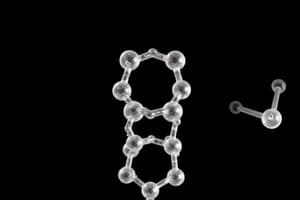Podcast
Questions and Answers
What does the VSEPR theory primarily focus on in terms of molecular geometry?
What does the VSEPR theory primarily focus on in terms of molecular geometry?
- Maximizing the attractive forces between electrons.
- Determining the mass of molecules based on density.
- Predicting the behavior of lone pairs only.
- Minimizing the repulsion between electron pairs. (correct)
Which of the following configurations corresponds to a molecule with four electron pairs?
Which of the following configurations corresponds to a molecule with four electron pairs?
- Square planar
- Tetrahedral (correct)
- Linear
- Trigonal planar
If a molecule has a trigonal bipyramidal electron geometry, how many electron pairs are involved?
If a molecule has a trigonal bipyramidal electron geometry, how many electron pairs are involved?
- 3
- 4
- 5 (correct)
- 2
What molecular shape is expected for a compound with the formula AB3?
What molecular shape is expected for a compound with the formula AB3?
To determine the molecular geometry of a molecule, what must be established first?
To determine the molecular geometry of a molecule, what must be established first?
Which shape represents a nonpolar molecule with four electron pairs?
Which shape represents a nonpolar molecule with four electron pairs?
What is the first step in drawing a Lewis structure?
What is the first step in drawing a Lewis structure?
If a central atom does not have enough electrons to complete an octet, what should be considered next?
If a central atom does not have enough electrons to complete an octet, what should be considered next?
What does a Lewis structure represent?
What does a Lewis structure represent?
How does the formal charge help in analyzing resonance structures?
How does the formal charge help in analyzing resonance structures?
What is the correct Lewis structure for the ammonium ion (NH4+)?
What is the correct Lewis structure for the ammonium ion (NH4+)?
Why would CO2 use double bonds instead of a single and triple bond?
Why would CO2 use double bonds instead of a single and triple bond?
Which of the following statements about Lewis structures is NOT true?
Which of the following statements about Lewis structures is NOT true?
What is the total number of valence electrons in the PCl4- ion?
What is the total number of valence electrons in the PCl4- ion?
Who is credited with the development of the Lewis dot structures?
Who is credited with the development of the Lewis dot structures?
Which statement is true regarding the resonance forms of CO32-?
Which statement is true regarding the resonance forms of CO32-?
What is indicated by formal charges in resonance structures?
What is indicated by formal charges in resonance structures?
Which resonance form would contribute the least to the resonance hybrid of CO32-?
Which resonance form would contribute the least to the resonance hybrid of CO32-?
How is the formal charge calculated?
How is the formal charge calculated?
In the context of resonance, which statement is correct about negative charges?
In the context of resonance, which statement is correct about negative charges?
Why is the resonance hybrid of CO32- not a simple average of its resonance forms?
Why is the resonance hybrid of CO32- not a simple average of its resonance forms?
What does a formal charge of zero on an atom indicate?
What does a formal charge of zero on an atom indicate?
Among the resonance forms of CO32-, which aspect is preferred for stability?
Among the resonance forms of CO32-, which aspect is preferred for stability?
What is the significance of having equal CO bond lengths in CO32-?
What is the significance of having equal CO bond lengths in CO32-?
Why do some resonance forms contribute more to the resonance hybrid than others?
Why do some resonance forms contribute more to the resonance hybrid than others?
What is the molecular geometry of a molecule with a tetrahedral electron pair arrangement?
What is the molecular geometry of a molecule with a tetrahedral electron pair arrangement?
How many degrees are the bond angles in a trigonal planar molecular geometry?
How many degrees are the bond angles in a trigonal planar molecular geometry?
Which electron pair geometry corresponds to six regions of electron density?
Which electron pair geometry corresponds to six regions of electron density?
For a molecule with the formula AB4, which shape indicates that it is nonpolar?
For a molecule with the formula AB4, which shape indicates that it is nonpolar?
Which of the following arrangements applies to a molecule exhibiting octahedral geometry?
Which of the following arrangements applies to a molecule exhibiting octahedral geometry?
How does VSEPR theory determine the geometry of a molecule?
How does VSEPR theory determine the geometry of a molecule?
What role does the central atom play in a Lewis structure when there are leftover valence electrons?
What role does the central atom play in a Lewis structure when there are leftover valence electrons?
How is the total number of valence electrons determined for a molecular ion?
How is the total number of valence electrons determined for a molecular ion?
What is the primary reason for utilizing multiple bonds in Lewis structures?
What is the primary reason for utilizing multiple bonds in Lewis structures?
What characteristic of resonance forms contributes to the stability of a molecule?
What characteristic of resonance forms contributes to the stability of a molecule?
When drawing a Lewis structure for CO2, why are double bonds preferred over a combination of a single and a triple bond?
When drawing a Lewis structure for CO2, why are double bonds preferred over a combination of a single and a triple bond?
Which of the following is the correct way to represent a charged ion using Lewis structures?
Which of the following is the correct way to represent a charged ion using Lewis structures?
Gilbert N. Lewis contributed significantly to which of the following concepts in chemistry?
Gilbert N. Lewis contributed significantly to which of the following concepts in chemistry?
In the Lewis structure of NH4+, how is the total valence electron calculated?
In the Lewis structure of NH4+, how is the total valence electron calculated?
Which process is essential in determining the proper arrangement of atoms and bonding in a molecule's Lewis structure?
Which process is essential in determining the proper arrangement of atoms and bonding in a molecule's Lewis structure?
What is the primary reason for preferring a resonance form that has the most zero formal charges?
What is the primary reason for preferring a resonance form that has the most zero formal charges?
How is the formal charge calculated for an atom in a molecule?
How is the formal charge calculated for an atom in a molecule?
Which resonance form of CH3NH2 (methylamine) is likely to contribute the least to the resonance hybrid?
Which resonance form of CH3NH2 (methylamine) is likely to contribute the least to the resonance hybrid?
What does it imply when all CO bonds in the CO32- ion have equal lengths?
What does it imply when all CO bonds in the CO32- ion have equal lengths?
In the resonance forms of CO32-, where should the negative charge ideally reside for optimum stability?
In the resonance forms of CO32-, where should the negative charge ideally reside for optimum stability?
Which factor contributes to the stability of a resonance form?
Which factor contributes to the stability of a resonance form?
Which statement about resonance structures is true?
Which statement about resonance structures is true?
What characteristic is preferred in resonance forms in terms of formal charges?
What characteristic is preferred in resonance forms in terms of formal charges?
What is the result if a resonance form exhibits the most non-zero formal charges?
What is the result if a resonance form exhibits the most non-zero formal charges?
In CO32-, which resonance form would likely contribute the highest percentage to the resonance hybrid?
In CO32-, which resonance form would likely contribute the highest percentage to the resonance hybrid?
Flashcards are hidden until you start studying
Study Notes
Lewis Structure
- A Lewis structure depicts the distribution of valence electrons in a molecule.
- Steps:
- Count total valence electrons.
- Connect atoms with single bonds.
- Subtract electrons used for bonds.
- Complete octets for exterior atoms (8 electrons).
- Subtract electrons used.
- Place remaining electrons on the central atom.
- If central atom lacks octet, try using multiple bonds.
Lewis Structure Examples
- CH4, NH3, H2O all have 8 valence electrons.
Resonance Structures
- Resonance refers to the delocalization of electrons in a molecule.
- Molecules with resonance structures exhibit multiple Lewis structures, each contributing to the overall structure.
- Example: CO2 has three resonance structures.
- The actual structure is a blend (resonance hybrid) of all resonance forms.
Formal Charge
- Formal charge represents the hypothetical charge an atom would have in a molecule if electrons were equally shared.
- Calculation: Formal Charge = Group Number - (Dashes + Dots).
- The sum of all formal charges in a molecule should equal the overall charge.
Resonance Stability
- Resonance forms with the most zero formal charges are more stable.
- Negative charges are preferred on more electronegative atoms.
- Resonance forms with fewer non-zero formal charges are more stable and contribute more to the resonance hybrid.
VSEPR Theory
- Valence Shell Electron Pair Repulsion (VSEPR) theory predicts molecular geometry based on electron pair repulsion.
- Key Points:
- Electron pairs repel each other to maximize distances, resulting in specific molecular shapes.
- A correct Lewis structure is required to apply VSEPR.
- Regions of Electron Density: Each single bond, lone pair, double bond, or triple bond represents one region of electron density.
Electron Pair Geometry
- Two electron pairs: Linear geometry (180°).
- Three electron pairs: Trigonal planar geometry (120°).
- Four electron pairs: Tetrahedral geometry (109.5°).
- Five electron pairs: Trigonal bipyramidal geometry (90° and 120°).
- Six electron pairs: Octahedral geometry (90°).
Molecular Geometry
- Molecular geometry refers to the arrangement of atoms in a molecule.
- To determine molecular geometry, first identify the electron pair geometry and then ignore lone pairs to see the arrangement of atoms.
Nonpolar Compounds
- Linear AB2, trigonal planar AB3, square planar and tetrahedral AB4, trigonal bipyramidal AB5, and octahedral AB6 are generally nonpolar.
- Any molecule not fitting these descriptions is likely polar.
Lewis Structures
- A Lewis structure shows the distribution of valence electrons in a molecule or ion.
- Follow these steps to draw a Lewis structure:
- Count the total number of valence electrons.
- Join atoms symmetrically with single bonds.
- Subtract electrons used in bonds.
- Complete the octet (8 electrons) on exterior atoms.
- Subtract used electrons.
- Place remaining electrons on the central atom.
- If the central atom lacks an octet, consider using multiple bonds.
- Examples: CH4, NH3, H2O (all have 8 valence electrons)
Resonance Structures
- Consider the CO2 molecule:
- There are multiple possible Lewis structures due to the double bonds.
- The actual structure is a blend of all resonance forms, called a resonance hybrid.
- The stability of each resonance form is determined by formal charge.
Formal Charge
- Formal charge is the charge an atom would have if bonding electrons were equally shared.
- Formula: Formal Charge = Group Number - (Dashes + Dots)
- Dashes represent bonds, dots represent lone pairs.
- The sum of all formal charges should equal the total charge of the molecule/ion.
- Resonance forms with more zero formal charges and negative charges on the most electronegative atoms are more stable.
VSEPR Theory
- Valence Shell Electron Pair Repulsion (VSEPR) theory explains the shape of molecules based on electron pair repulsion.
- Electron pairs (bonds and lone pairs) want to maximize distance from each other.
- Steps:
- Draw the Lewis structure.
- Determine the number of electron density regions around the central atom (bonds or lone pairs).
- This gives the electron pair (or basic) geometry.
- Ignore lone pairs to get the molecular geometry.
Electron Pair Geometry
- 2 electron pairs: Linear (180°)
- 3 electron pairs: Trigonal planar (120°)
- 4 electron pairs: Tetrahedral (109.5°)
- 5 electron pairs: Trigonal bipyramidal (90° and 120°)
- 6 electron pairs: Octahedral (90°)
Molecular Geometry
- The shape of a molecule is determined by the arrangement of atoms, ignoring lone pairs.
- Examples:
- Tetrahedral (CH4)
- Trigonal pyramidal (NH3)
- Bent (H2O)
Nonpolar Compounds
- Linear AB2 (BeCl2)
- Trigonal planar AB3 (BF3)
- Square planar and Tetrahedral AB4 (CH4, SiCl4)
- Trigonal bipyramidal AB5 (PCl5)
- Octahedral AB6 (SF6)
- Any other combination is polar.
Gilbert N. Lewis
- American physical chemist.
- Discovered the covalent bond and the concept of shared electron pairs.
- Known for Lewis dot structures and his contributions to valence bond theory.
- Coined the term "photon" in 1926.
- His research covered areas like chemical thermodynamics, photochemistry, and isotope separation.
- Died in his lab of cyanide poisoning on March 23, 1946.
Studying That Suits You
Use AI to generate personalized quizzes and flashcards to suit your learning preferences.




